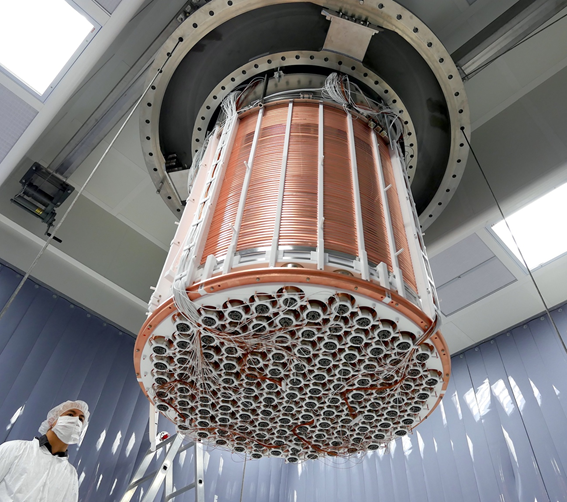Observation of Excess Events in the XENON1T Dark Matter Experiment
[2020-06-19]
Scientists from the international XENON collaboration1), involving Professor. Yoshitaka Itow (KMI, ISEE), Associate Professor. Masaki Yamashita (ISEE), YLC Assistant Professor Shingo Kazama (KMI, IAR), announced that data from their XENON1T, the world's most sensitive dark matter experiment, show a surprising excess of events. The scientists do not claim to have found dark matter. Instead, they say to have observed an unexpected rate of events, the source of which is not yet fully understood. The signature of the excess is similar to what might result from a tiny residual amount of tritium (a hydrogen atom with one proton and two neutrons), but could also be a sign of something more exciting--such as the existence of a new particle known as the solar axion or the indication of previously unknown properties of neutrinos. Results from this research were announced during an online seminar for researchers by the XENON collaboration on Wednesday, June 17 (16:00, Central European Summer Time; 23:00, Japan Standard Time)
Reference URL:
Press release by XENON collaboration (English)
http://www.xenon1t.org
Press release by Kavli IPMU, University of Tokyo
https://www.ipmu.jp/en/20200617-XENON1T-ExcessEvents
Press release by KMI, Nagoya University
http://www.kmi.nagoya-u.ac.jp/eng/blog/2020/06/18/research-observation-of-excess-events-in-the-xenon1t-dark-matter-experiment/
Paper details
Title:Observation of Excess Electron-Recoil Events in XENON1T
Author: XENON Collaboration
Pre-print https://arxiv.org/abs/2006.09721
*1)
XENON Collaboration:
An international alliance consisting of 163 researchers from 28 institutions in 10 countries and regions, mainly in Europe, the United States, and Japan. Institutions from Japan include the Kavli Institute for the Physics and Mathematics of the Universe (Kavli IPMU), University of Tokyo; the Institute for Cosmic Ray Research (ICRR), University of Tokyo; the Institute for Space-Earth Environmental Research (ISEE), Nagoya University; the Kobayashi-Maskawa Institute for the Origin of Particles and the Universe (KMI), Nagoya University; and the Graduate School of Science, Kobe University.
(Figure) The bottom of the XENON1T time projection chamber from below. The back ends of the photomultiplier tubes recording the scintillation light from events inside the chamber are clearly visible in their PTFE holding structure, as are the copper rings in the cylinder walls that shape the drift field which guides the ionization signal electrons to the top of the chamber. (Credit: XENON Collaboration)

